|
January 2004
**** most recent update |
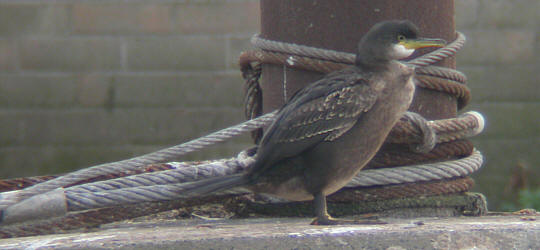 |
|
First winter Shag - Lake Lothing - December
2003 - © Andrew Easton
|
RED-THROATED
DIVER Gavia stellata
****
Kessingland - 2nd (3 N, 10 S), 3rd (2 N, 87 S), 4th (1499
N, 97 S, 21 on sea in 3.5hrs seawatching), 5th (6 N, 46 S, 9 o/s), 6th
(5 N, 31 S), 7th (10 S, 3 S, 2 o/s), 8th (1 N, 1 S), 9th (13 N, 16 S),
10th (1 N, 14 S), 11th (13 N, 3 S), 12th (7 N, 2 S), 13th (2 N, 5 S),
14th (7 N, 8 S), 15th (3 N, 18 S, 4 o/s), 16th (1 N, 16 S, 3 o/s), 17th
(4 S), 18th (20 N, 8 S, 1 o/s), 19th (8 N, 4 S, 1 o/s), 20th (40 N,
11 S), 21st (1 S), 22nd (4 N), 23rd (8 N, 2 S), 24th (2 N,1 S), 25th
(166 N, 1 S, 4 o/s), 26th (7 S, 1 o/s), 27th (2 N, 6 S), 28th (1 N,
3 S), 29th (2 N, 4 S), 30th (9 N, 18 S).
LITTLE GREBE Tachybaptus ruficollis
****
Hamilton Dock - 10th (1), 11th (2), 31st (1).
Lake Lothing - 10th (5+), 11th (4), 17th (3).
Leathes Ham - 10th (4).
Lound Waterworks - 10th (2).
GREAT CRESTED GREBE Podiceps cristatus
****
Kessingland - 3rd (1 S), 4th (1 o/s), 5th (1 o/s), 7th (1
S), 8th (1 S), 10th (1 N), 18th (1 N), 30th (1 S).
Hamilton Dock - 11th (1).
SLAVONIAN GREBE Podiceps auritus
One was in the Yacht Basin in Lowestoft Harbour on the 3rd, viewable
from the South Pier. It was still present there early morning on the
4th, though it later swam westwards along Lake Lothing. It was still
present on Lake Lothing on the 5th, but was only viewable distantly
from the harbour bridge.
On the 10th, 11th, 17th and 18th it was viewable distantly, looking
eastwards from the railway footbridge. It was just beyond the large
orange mooring buoy in mid channel.
As it was seen to both swim and dive on several occasions it was flagrantly
in breach of local harbour bye-laws!
  |
|
Slavonian
Grebe - Lowestoft Harbour - January 4, 2004 - © Tim Brown
|
FULMAR Fulmarus glacialis
****
The first of the year flew north past Kessingland on the 20th. Single
birds were then noted northbound on the 26th, 27th and 30th.
GANNET Morus bassanus
****
Kessingland - 1st (7 N, 1 S), 2nd (3 N), 9th (3 N), 10th
(11 N), 11th (1 N), 26th (7 N), 30th (78 N).
Ness Point - 1st (2 N, 5 S).
CORMORANT Phalacrocorax carbo
****
Kessingland - 3rd (2 S), 4th (3 N, 2 S), 5th (1 N, 2 S, 1
o/s), 6th (1 N, 1 S), 7th (2 N), 8th (2 S, 1 o/s), 9th (1 N, 1S), 10th
(1 N, 2 S), 12th (1 N), 13th (1 N), 14th (1 S), 20th (2 S, 1 o/s), 22nd
(7 S), 23rd (5 S), 24th (3 S), 25th (1 N), 26th (9 N, 2 S), 29th (3
N), 30th (1 N, 4 S).
Lake Lothing - 13th (flock of 12 flying westward, presumably
to roost).
A returning colour ringed bird was in Lowestoft Harbour on the 4th and
9th. It was ringed in the nest in The Netherlands in June 1999, and
first noted in Lowestoft in September of that year. It has returned
to winter in Lowestoft each year since then.
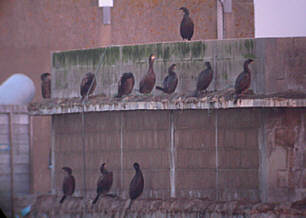 |
|
Shags
- Lowestoft Harbour - 18th January 2004 © Andrew Easton
|
EUROPEAN
SHAG Phalacrocorax aristotelis
****
Four were present along Lake Lothing on the 1st to 4th at least,
and an additional three flew south past Ness Point on the 1st. One of
those on Lake Lothing was colour ringed, and proved like four earlier
colour ringed individuals seen here to have originated from the Isle
of May in the Firth of Forth, Scotland.
During the day they generally favour the stretch of Lake Lothing between
the railway footbridge and the yacht club. The second winter bird at
least was roosting at Leathes Ham on the evening of December 26th.
On the 10th and 11th ten were roosting on the Kittiwake Wall at
the harbour mouth. This had increased to 11 on the 17th and 18th, as
can be seen in the photo above. The colour ringed bird was still present
as was a metal ringed individual. As usual their attempts at landing
and subsequent squabbling over spaces provided much entertainment, the
top ledge is clearly the hottest property around!
Eleven were again roosting there on the 24th, and after the brief spell
of wintery weather this had increased to 15 on the 31st. Perhaps in
response to the strong winds on the 31st several of them were sitting
down on the old Kittiwake nests rather than standing as they usually
do.
LITTLE EGRET Egretta garzetta
One flew along the River Waveney at St. Olaves on the 17th, and
two or three were along the south wall of Breydon Water on the 24th,
with one at Burgh Castle on the 25th.
GREY HERON Ardea cinerea
One was with the gull flock at Burnt Hill Lane on the 18th. It seems
to be sitting in the middle of the flock every time we visit.
BEWICK'S SWAN Cygnus (columbianus)
bewickii
A pair were just outside our area on the 5th at Beccles Marsh. Two were
seen at Kessingland on the 17th.
Four adults were on marshes at Worlingham on the 24th.
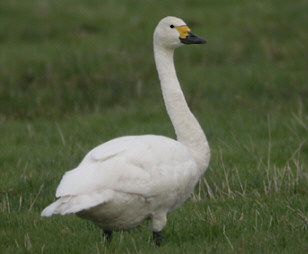 |
|
Bewick's Swans - Beccles Marshes - January 5, 2004 ©Mike
Parker
|
WHOOPER SWAN Cygnus cygnus
One was seen at Kessingland on the 17th, and possibly the same bird flew south past there on the 18th. A lone juvenile was at Burgh Castle Marshes on the 25th.
PINK-FOOTED GOOSE Anser brachyrhynchus
A flock of 47 flew south-west over Jay Lane, Lound at dusk on the 18th. A lone bird flew eastwards over Castle Marshes, North Cove on the 24th.
In contrast to this just across the border several thousand flew into the Berney Marshes reserve at Halvergate at dusk on the 25th.
GREYLAG GOOSE Anser anser
60 were at Lound Waterworks on the 10th, and six were at Leathes Ham accompanied by the Emperor x Greylag hybrid the same day. Fifteen were on Oulton Broad on the 18th along with the Emperor × Greylag hybrid.
CANADA GOOSE Branta canadensis ****
Three were with Greylags at Lound Waterworks on the 10th. Four were on Leathes Ham on the 24th, Four were at Lound Waterworks on the 31st.
BARNACLE GOOSE Branta leucopsis
282 were at Lound Waterworks on the 10th, they flew in from the west, presumably from Fritton Lake. A flock of 45-50 flew north along the coast at Pakefield on the 11th.
A decidedly dodgy individual was at Oulton Broad on the 11th and 13th, it seems to wander from the local Pets Corner occasionally. On the 13th it was accompanied by a Muscovy!
BRENT GOOSE Branta bernicla bernicla
Kessingland - 1st (56 S), 2nd (7 N, 30 S), 3rd (48 S), 4th (1 S), 8th (1 N), 11th (1 N), 14th (2 N), 21st (5 S).
Ness Point - 1st (35 S).
EGYPTIAN GOOSE Alopochen aegyptiacus
A pair were at Leathes Ham on the 10th, 11th, 13th and 24th, with two pairs at Oulton Broad on the 13th.
SHELDUCK Tadorna tadorna
Kessingland - 1st (210 S), 2nd (32 S), 3rd (13 S), 21st
(2 S).
Ness Point - 1st (52 S).
WIGEON Anas penelope
****
Kessingland - 1st (422 S), 2nd (12 N, 22 S), 3rd (26 S),
4th (78 N, 45 o/s), 5th (8 o/s), 8th (5 S), 9th (20 N), 11th (2 N, 65
o/s), 12th (2 S), 24th (2 N), 26th (26 N, 2 S), 27th (5 N).
Ness Point - 1st (134 S, 60 W inland), 7th (100
east out to sea high).
Leathes Ham - 1st (15), 10th (15), 17th (30), 24th (12).
Castle Marshes, North Cove - 24th (185 E), 25th (400+).
GADWALL Anas strepera
****
Kessingland - 1st (6 S).
Leathes Ham - 1st (9), 10th (9), 24th (12).
Ness Point - 1st (2 S).
Lound Waterworks - 10th (9), 31st (30).
Castle Marshes, North Cove - 24th (6).
TEAL Anas crecca
Kessingland - 1st (1 N, 25 S), 2nd (12 S), 10th (15 N, 4
S, 18 o/s), 20th (1 N).
Ness Point - 1st (97 S).
Castle Marshes, North Cove - 24th (250+).
MALLARD Anas platyrhynchos
Kessingland - 1st (2 S), 3rd (1 S).
PINTAIL Anas acuta
Kessingland - 1st (61 S), 2nd (7 S), 3rd (8 S).
Ness Point - 1st (9 S).
SHOVELER Anas clypeata
Kessingland - 1st (4 S), 10th (2 S).
Leathes Ham - 1st (7), 10th (30), 11th (40+),
17th (100+).
Ness Point - 1st (18 S).
Oulton Broad - 11th (4 SW).
Numbers at Leathes Ham are quite impressive at the moment, with many
of the birds displaying. The flooding over the last few years may have
stopped people wandering around, but the waterfowl are booming. Numbers
of feral Mallards are way down and have been replaced by a range of
wild ducks which previously only dropped in in minute numbers for very
short periods before moving on. A great improvement.
RED-CRESTED
POCHARD Netta rufina
****
The drake at Leathes Ham first seen on December 14th was still
present on the 31st.
Viewing can be difficult, and the bird is best looked for from either
the railway bridge at the western end of the Ham or from the main car
park at Normanston Park. It tends to keep to the far side opposite the
car park with the Wigeon and Gadwall. With a bit of luck it will linger
for the coming months, it'll certainly add a bit of sparkle to the cold
days that lie ahead!!!
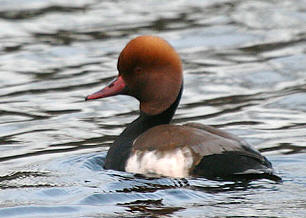 |
|
Red-crested
Pochard - Leathes Ham - December 26, 2003 - ©Tim Brown
|
POCHARD
Aythya ferina
****
Leathes Ham - 1st (3), 10th (6), 24th (6), 31st (3).
Ness Point - 1st (1 S).
Kessingland - 4th (9 N).
TUFTED DUCK Aythya fuligula
****
Kessingland - 1st (1 S), 13th (1 S), 22nd (1 S).
Leathes Ham - 1st (15), 10th (10), 24th (22).
Ness Point - 1st (3 S).
Oulton Broad - 13th (7), 31st (6).
Lound Waterworks - 31st (18).
SCAUP Aythya marila
****
The female was still on Oulton Broad on the 22nd at least. It was
looked for on the 31st but could not be found. First noted on December
18th, on most occasions it has been seen feeding alone along the north
shore in the vicinity of the converted Maltings buildings. Though more
recently it has been between the Boulevard and the Wherry Hotel, often
with Tufted Ducks.
The dull eye colouration and the white patches confined to the sides
of the face, with the white over the bill still developing, indicate
it is a first winter individual.
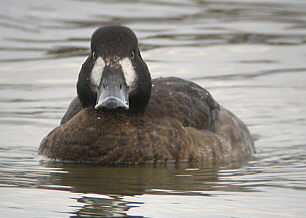 |
|
Scaup
- Oulton Broad - January, 10th 2004 - © Andrew Easton
|
COMMON EIDER Somateria mollissima
****
Kessingland - 1st (2 S), 2nd (4 S), 4th (7 N), 10th (3 N),
26th (5 N), 28th (2 N).
Ness Point - 1st (6 N).
COMMON
SCOTER Melanitta nigra
****
Kessingland - 2nd (1 N, 5 o/s), 3rd (2 N), 4th (8 o/s), 5th
(3 o/s), 6th (6 S), 9th (4 N), 10th (3 N, 2 o/s), 22nd (9 N), 26th (33
N).
VELVET
SCOTER Melanitta fusca
Four flew south past Kessingland on the 10th.
GOLDENEYE Bucephala clangula
****
Kessingland - 1st (2 S), 8th (1 S), 30th (1 N).
Ness Point - 1st (3 S).
SMEW Mergus albellus
A drake flew south past Kessingland on the 1st.
RED-BREASTED MERGANSER Mergus serrator
Kessingland - 2nd (4 S).
Ness Point - 1st (1 S).
Hamilton Dock - 2nd (pair).
GOOSANDER Mergus merganser
****
A male was on Oulton Broad on the 28th, and two males and a female
drifted south on the sea past Kessingland on the 30th.
MARSH HARRIER Circus aeruginosus
On the 7th an immature flew south past Kessingland about one kilometre
offshore.
HEN HARRIER Circus cyaneus
A ringtail was seen at Carlton Marshes and also across the river
at Fisher Row/Oulton Marshes on the 4th.
PEREGRINE Falco
peregrinus
One was seen over Kessingland beach on the 17th.
MERLIN Falco columbarius
A female was seen perched on a fence post at Burgh Castle on the
24th.
WATER RAIL Rallus aquaticus
Two were heard at Burgh Castle on the 11th, with one seen and heard
there on the 25th.
COOT Fulica atra
At least 97 were at Leathes Ham on the 24th, another beneficiary
of the raised water levels.
OYSTERCATCHER Haematopus ostralegus
One was along Lake Lothing on the 10th.
AVOCET Recurvirostra avosetta
One was at Burgh Castle on the 25th.
RINGED PLOVER Charadrius hiaticula
Lake Lothing - 1st (3).
Hamilton Dock - 3rd (1), 7th (1).
Lowestoft North Beach - 4th (4).
Lowestoft South Beach - 23rd (2).
GOLDEN PLOVER Pluvialis apricaria
At least 1500 were in fields at Worlingham on the 17th.
LAPWING Vanellus vanellus
500 were on the mudflats at Burgh Castle on the 10th, but many 1000's
more were on Berney Marshes on the far side of the estuary.
On an altogether smaller scale a lone bird was mixed in with a flock
of 150 gulls, mostly Black-headed, on Lowestoft North Beach early morning
on the 10th.
KNOT Calidris canutus
One flew south past Kessingland on the 1st.
SANDERLING Calidris alba ****
Hamilton Dock - 1st (1), 3rd (1), 4th (1), 7th (4), 28th
(2).
Ness Point - 1st (1 S), 15th (1).
South Beach, Lowestoft - 4th (4), 5th
(1), 9th (13), 18th (10), 23rd (14), 29th (2), 31st (3).
Pakefield - 5th (3).
Kessingland - 26th (6 on beach), 30th (18 o/b).
PURPLE SANDPIPER Calidris maritima
Ness Point - 1st (1), 11th (4), 13th (6), 16th (1), 17th
(5), 18th (5), 23rd (5), 27th (6), 28th (4).
Hamilton Road - 4th ( 1 on shoreline rocks).
North Beach - 7th
(2).
DUNLIN Calidris alpina
Kessingland - 1st (3 S), 16th (1 S).
Ness Point - 1st (3 S).
RUFF Philomachus pugnax
One flew north past Kessingland on the 2nd.
WOODCOCK Scolopax rusticola
One was flushed at Lound on the 10th, and another was seen at Kessingland
Sewage Works on the 18th. Two were seen at North Cove on the 24th.
JACK SNIPE Lymnocryptes minimus
Two were seen in a field of stubble at Mutford on the 26th.
COMMON SNIPE Gallinago gallinago
Four were seen at Castle Marshes, North Cove on the 24th.
BLACK-TAILED GODWIT Limosa limosa
Burgh Castle - 10th (24), 24th (30).
BAR-TAILED GODWIT Limosa lapponica
One was at Burgh Castle on the 24th.
SPOTTED REDSHANK Tringa erythropus
One was a Burgh Castle on the 10th, with two there on the 25th.
REDSHANK Tringa totanus
****
Ness Point - 1st (1 S).
Lake Lothing - 10th (14).
Kessingland Levels - 31st (7).
TURNSTONE Arenaria interpres ****
Lake Lothing - 1st (12).
Kessingland - 3rd (1 N), 4th (2 S), 5ht (2 N), 6th (2
N), 7th (2 N), 11th (4 on beach), 12th (1 o/b), 13th (1 o/b), 14th (7
o/b), 16th (4 o/b), 22nd (7 o/b), 30th (3 o/b).
Hamilton Dock - 4th (11), 7th (13).
Pakefield
- 5th (4), 17th (7).
Ness Point - 5th (4), 17th (6).
Oulton Broad - 10th (1), 24th (5).
South Beach,
Lowestoft - 9th (7).
South Pier
- 17th (27), 18th (72 at dusk), 24th (76 at dusk), 31st (57 at dusk).
ARCTIC SKUA Stercorarius parasiticus
One dark phase bird flew south past Ness Point and then Kessingland
on the 1st.
MEDITERRANEAN GULL Larus melanocephalus
****
South
Pier - 3rd (1, 2nd winter), 5th (2, 1st winter + 2nd winter),
18th (1, 2nd winter), 29th (1, 2nd winter).
Pakefield - 3rd (1, 2nd winter), 5th (1, adult), 6th (2,
adult + 2nd winter), 17th (4, 1 adult, 2 2nd winter, 1 1st winter).
Kessingland
- 4th (1 adult south), 12th (1 N adult), 13th (1N, 1S both adults),
14th (1 S 2nd winter), 16th (1 S adult), 24th (1 N adult), 26th (1 N
2nd winter).
Lake Lothing - 13th (1 adult).
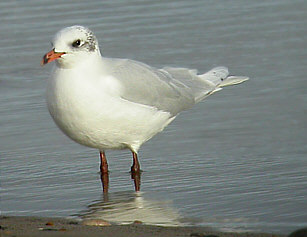 |
|
Mediterranean
Gull - Pakefield Beach - December 14, 2003 - ©Robert Wilton
|
LITTLE GULL Larus minutus
At least five adults were feeding at the sewage outfall off Ness
Point on the 1st, and ten flew south past Kessingland. On the 2nd 24
flew south past the North Beach, Lowestoft.
An impressive count of 429 southbound birds was made at Kessingland
on the 2nd. Comprised mostly of small groups of 5-12, a couple of 20,
one of 50 and an extended group (i.e. a few gaps) of 104. Total watch
time of 3 hrs, 1.5 a.m. (357), 1.5 p.m. (72).
Kessingland - 3rd (20 S), 9th (1 S), 16th (1 S).
YELLOW-LEGGED GULL Larus michahellis
An adult was at Ness Point on the 1st.
KITTIWAKE Rissa tridactyla
****
Kessingland - 1st (1 N, 24 S), 2nd (2 N, 1 S), 3rd (1 S),
5th (2 N 1 S), 6th (3 N 5 S), 7th (1 N 5 S), 8th (69 S), 9th (5 N 12
S), 10th (7 N, 7 S), 11th (167 N, 23 S), 12th (8 N, 18 S), 13th (132
N, 10 S), 14th (9 S), 15th (13 N, 3 S), 16th (262 N, 244 S), 17th (3
S), 18th (6 N), 19th (1 N, 3 S), 21st (1 S), 22nd (3 N, 2 S), 23rd (1
N, 3 S), 24th (2 N), 26th (201 N, 2 S), 30th (67 N).
RAZORBILL Alca torda
This Razorbill was found on Lowestoft South Beach on the 4th, it
was taken into care and collected by the RSPCA.
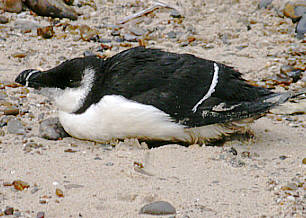 |
|
Razorbill
- Lowestoft South Beach - January 4th 2004 - © Andrew Easton
|
AUK
sp Alcidae
****
Kessingland - 1st (1 S), 2nd (2 N, 1 S), 3rd (8 S), 4th (2
N, 3 S), 5th (2 N), 6th (1 N, 1 S), 7th (2 N, 1 S), 8th (2 S), 9th (5
N), 10th (1 N), 11th (6 N), 13th (1 N), 15th (2 N), 16th (2 N, 17 S,
3 o/s), 20th (26 N, 15 S), 22nd (11 N), 23rd (15 N), 26th (7 N), 28th
(1 N), 29th (2 N), 30th (10 N).
STOCK DOVE Columba oenas
An impressive flock of 150 was in fields between Mutford and Hulver
on the 17th. Ten were at Carlton Marshes on the 24th.
BARN OWL Tyto alba
Parkhill, Oulton - 18th.
North Cove - 24th (1).
Carlton Marshes - 24th (1).
LITTLE OWL Athene noctua
One was seen along Jay Lane, Lound on the 4th.
TAWNY OWL Strix
aluco
One was in Gunton Woods on the 2nd.
KINGFISHER Alcedo atthis
Lowestoft Harbour - 4th (1).
Lake Lothing - 10th (2), 11th (1), 17th (1).
Oulton Broad - 10th (1+).
Carlton
Colville - 11th (1).
SHORE LARK Eremophila alpestris
****
Three were seen on Kessingland Beach on the 27th.
ROCK PIPIT Anthus petrosus
One was at Ness Point on the 1st and 11th.
GREY WAGTAIL Motacilla cinerea
****
Oulton Broad - 1st (2), 4th (1), 24th (1).
Lowestoft Harbour - 3rd (1).
Kessingland Sewage Works - 10th (1), 11th (3), 18th (1),
31st (1).
PIED WAGTAIL Motacilla alba
****
Now that they have lost the temporary cover of the large Christmas tree,
the Lowestoft Town Centre Pied Wagtails are back in the bare trees outside
Dorothy Perkins. There were eleven there on the 14th; and ten on the
21st and 23rd.
Forty were at Kessingland Sewage Works on the 31st.
 |
|
Bohemian
Waxwing- Lowestoft - January 2004 - © Tim Brown
|
BOHEMIAN
WAXWING Bombycilla garrulus
Burnt Hill Way, Carlton Colville - 1st (6), 3rd (3), 4th
(3)..
Belton - 10th (1 flew south).
St Pauls Close, Beccles - 16th (3), 17th (3), 20th (3).
Gisleham - One has been reported beside the main A12 just
south of the Focus DIY Store on the 16th and 17th at least.
Worlingham - On the 24th two were beside the A146 just
east of the Worlingham roundabout, with three there on the 25th. Presumably
the same three seen intermittantly at St Pauls Close in Beccles..
STONECHAT Saxicola torquata
Worlingham - 24th (2).
Castle Marshes, North Cove - 24th (2).
Carlton Marshes - 24th (2).
FIELDFARE Turdus pilaris
Forty were in fields along Jay Lane, Lound on the 4th. A flock of
100 were seen between Mutford and Ellough on the 17th.
REDWING Turdus iliacus
Ten were at Gunton on the 2nd. Six were with a flock of 100 Fieldfares
between Mutford and Ellough on the 17th.
CETTI'S WARBLER Cettia cetti
Single birds were heard along the River Waveney at North Cove and
Castle Marshes on the 24th.
BLACKCAP Sylvia atricapilla
A male was in a Kessingland garden on the 4th.
CHIFFCHAFF Phylloscopus collybita ****
At least four were at Kessingland Sewage Works on the 10th. On the
11th at least seven birds were present including one very grey/brown
and white individual showing characteristics of SIBERIAN CHIFFCHAFF
P. (c.) tristis unfortunately it remained silent throughout,
as did all the others present. Too busy feeding apparently. One individual
had a very stunted bill of only 3 to 4mm in length but appeared quite
healthy nonetheless, and another had a crippled foot.
The Siberian Chiffchaff type bird was still present on the
18th, along with at least five nominate type birds including the individual
with the deformed bill.
At least three Chiffchaffs were present on the 20th, with at least six
there again on the 24th.
The Siberian Chiffchaff type bird was the only Chiffchaff
seen on the 31st, although the weather was poor, but in the dull light
the plumage lacks any green tones at all.
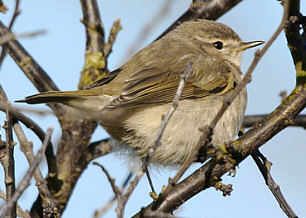 |
|
Possible
Siberian Chiffchaff - Kessingland Sewage Works - January 11th,
2003 - © Tim Brown
|
FIRECREST
Regulus ignicapilla
One was at Kessingland Sewage Works on the 10th, 11th, 18th and
24th. It can be frustratingly elusive at times.
MARSH TIT Parus palustris
Noted at Worlingham and North Cove on the 24th.
TREECREEPER Certhia familiaris
****
Seen at North Cove on the 24th, and heard at Lound Waterworks on
the 31st.
BEARDED TIT Panurus biarmicus
At least two were calling at Burgh Castle on the 11th, with many more
calling there on the 25th.
JACKDAW Corvus monedula
Over 300 were in the gull roost field at Burnt Hill Lane, Carlton
Coliville on the 17th.
HOUSE SPARROW Passer domesticus
At least 26 were around Holly Road, Oulton Broad on the 31st.
CHAFFINCH Fringilla coelebs
A flock of 80 were in horse paddocks at Lound on the 10th.
LESSER REDPOLL Carduelis cabaret
A flock of at least 50 was in Alder carr at North Cove on the 24th
and 25th.
GOLDFINCH Carduelis carduelis
Four were at North Cove on the 24th.
GREENFINCH Carduelis chloris
Ten were with Chaffinches at Lound on the 10th. Six were at Carlton
Marshes on the 24th..
SISKIN Carduelis spinus
Two flew over Caldecott Road, Oulton Broad on the 4th. Five
were with Lesser Redpolls at North Cove on the 24th and 25th. Generally
rather scarce this winter so far.
BULLFINCH Pyrrhula pyrrhula ****
Gunton - 2nd (2).
North Cove - 24th (2).
Carlton Marshes - 24th (5).
Lound Waterworks - 31st (1).
SNOW BUNTING Plectrophenax nivalis
****
Kessingland - 1st (45), 2nd (50+), 3rd (50+), 4th (100+),
5th (100+), 6th (100+), 7th (75), 8th (60), 9th (80), 11th (97), 12th
(80+), 13th (80+), 14th (80+), 15th (80+), 16th (80+), 17th (100+),
18th (100+), 20th (80+), 21st (100+), 22nd (100+), 23rd (100+), 24th
(100+), 25th (100+), 26th (100+), 27th (40), 28th (100+), 29th (100+),
30th (100+).
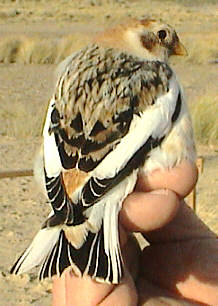 |
With such a restless species as Snow Bunting
when a large flock builds up it can be extremely difficult to
obtain an accurate total, and while counts of over 100 were made
at Kessingland early in the month numbers seemed to have fallen
back slightly since then. On the 17th a concerted effort was made
to ring as many of the birds present as possible. |
|
Snow
Bunting - Kessingland - 17th January 2004 - © Paul Read
|
|
BIRDS
RECORDED IN LIZARD LAND DURING 2004: Red-throated
Diver, Little Grebe, Great Crested Grebe, Slavonian Grebe, Fulmar, Gannet,
Cormorant, Eurasian Shag, Little Egret, Grey Heron, Mute Swan, Bewick's
Swan, Whooper Swan, Pink-footed Goose, Greylag Goose, Canada Goose,
Barnacle Goose, Dark-bellied Brent Goose, Egyptian Goose, Shelduck,
Wigeon, Gadwall, Teal, Mallard, Pintail, Shoveler, Red-crested Pochard,
Pochard, Tufted Duck, Scaup, Eider, Common Scoter, Velvet Scoter, Goldeneye,
Smew, Red-breasted Merganser, Goosander, Marsh Harrier, Hen Harrier,
Sparrowhawk, Kestrel, Merlin, Peregrine, Red-legged Partridge, Pheasant,
Water Rail, Moorhen, Coot, Oystercatcher, Avocet, Ringed Plover, Golden
Plover, Lapwing, Knot, Sanderling, Purple Sandpiper, Dunlin, Ruff, Jack
Snipe, Common Snipe, Woodcock, Black-tailed Godwit, Bar-tailed Godwit,
Curlew, Spotted Redshank, Redshank, Turnstone, Arctic Skua, Mediterranean
Gull, Little Gull, Black-headed Gull, Common Gull, Lesser Black-backed
Gull, Herring Gull, Yellow-legged Gull, Great Black-backed Gull, Kittiwake,
Guillemot, Razorbill, Feral Dove, Stock Dove, Wood Pigeon, Collared
Dove, Barn Owl, Tawny Owl, Little Owl, Kingfisher, Green Woodpecker,
Great Spotted Woodpecker, Sky Lark, Shore Lark, Meadow Pipit, Rock Pipit,
Grey Wagtail, Pied Wagtail, Bohemian Waxwing, Wren, Dunnock, Robin,
Stonechat, Blackbird, Fieldfare, Song Thrush, Redwing, Mistle Thrush,
Cetti's Warbler, Blackcap, Chiffchaff, (Siberian Chiffchaff), Goldcrest,
Firecrest, Bearded Tit, Long-tailed Tit, Marsh Tit, Coal Tit, Blue Tit,
Great Tit,, Eurasian Treecreeper, Jay, Magpie, Jackdaw, Rook, Carrion
Crow, Starling, House Sparrow, Chaffinch, Greenfinch, Goldfinch, Siskin,
Linnet, Lesser Redpoll, Bullfinch, Snow Bunting, Yellowhammer, Reed
Bunting.